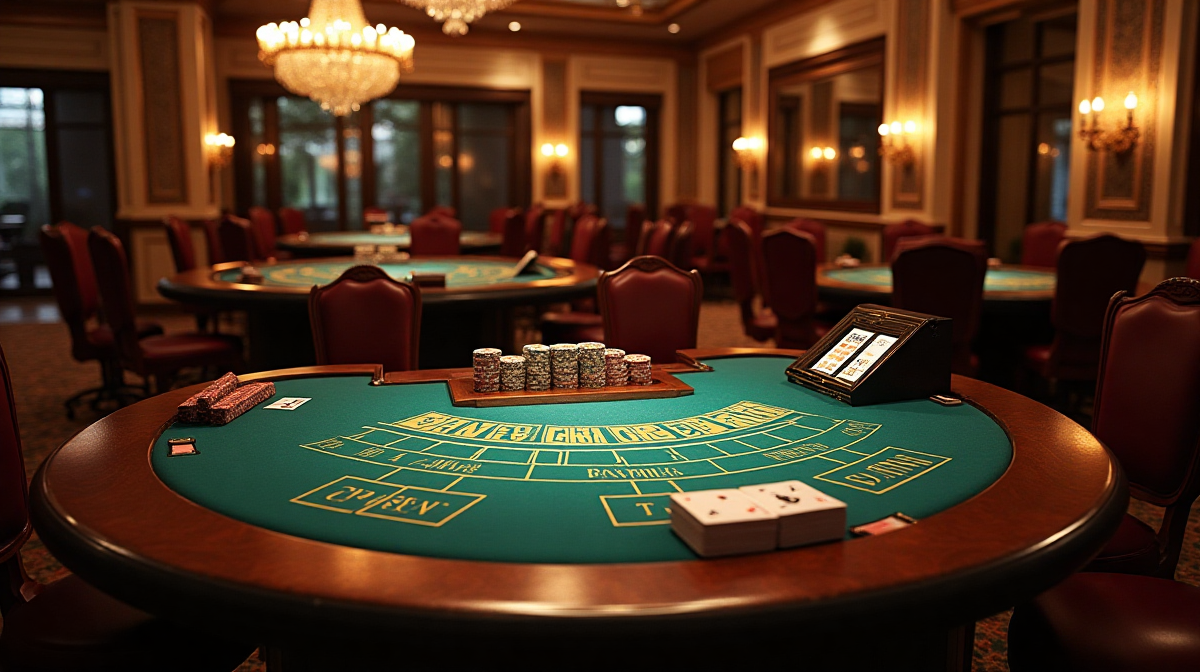Baccarat Game Guide: Beginner to Pro in 7 Days
What is Baccarat? A Brief History & Overview
Baccarat, often associated with James Bond and high-roller casinos, has a rich history dating back to 19th-century France. Legend has it the game originated in Italy, but it was popularized by the French aristocracy. While it appears complex, the core of the baccarat game is remarkably simple. It’s a comparison card game played between two hands, the Player and the Banker. Any player can bet on either hand, or on a tie. The hand with a total closest to nine wins. Understanding this fundamental principle is the first step towards mastering the game.
Understanding the Table Layout: Banker, Player, Tie
The baccarat table can initially seem intimidating, but it’s logically organized. The main areas are designated for the Player and Banker bets. A separate area is for Tie bets. You'll also find spaces for placing chips. Different casinos may have slight variations, but the core layout remains consistent. The Dealer, or Croupier, manages the cards and payouts. Often, casinos will have a minimum and maximum bet, so it's important to be aware of these limits before you start. It’s also worth noting the presence of scoreboards that track previous results, which some players use (with varying degrees of success) to inform their bets.

Core Concepts: The Goal of the Game & Card Values
The primary goal in baccarat is to predict which hand – Player or Banker – will have a total closest to nine. Card values are straightforward: Ace = 1, 2-9 = face value, and 10, Jack, Queen, and King = 0. When a hand's total exceeds nine, only the units digit is considered. For example, a hand totaling 17 becomes 7. This simple scoring system is key to understanding the game. Knowing this, a hand reaching 8 or 9 is considered a “natural” and typically results in an immediate win, depending on which hand achieves it first.
Debunking Myths: Is Baccarat a Game of Skill or Luck?
Despite the strategies some players employ, baccarat is predominantly a game of luck. While understanding the rules and probability can enhance your enjoyment, you can’t influence the cards dealt. The house edge is relatively low, making it attractive, but it's crucial to recognize that past results don’t guarantee future outcomes. The “Gambler’s Fallacy” – the belief that past events influence future random events – is a common trap. You’ll hear players discussing elaborate systems, some even involving what they call a 4Bet strategy, but fundamentally, the outcome is determined by chance.
Baccarat Variations: Punto Banco, Chemin de Fer, Baccarat Banque
There are several variations of baccarat. Punto Banco (also known as North American Baccarat) is the most common, especially in casinos. In Punto Banco, the casino always acts as the Banker. Chemin de Fer and Baccarat Banque are less common and involve players taking turns being the Banker. These variations offer more player control but are rarely found in standard casino environments.
Placing Bets: Understanding Banker, Player & Tie Bets
Before each hand, players must place their bets on either the Player, Banker, or Tie. The Banker bet has a slightly lower house edge, but casinos typically charge a commission (usually 5%) on winning Banker bets. The Player bet has a slightly higher house edge. The Tie bet offers the highest payout but has the lowest probability of winning and a significantly higher house edge. Understanding these odds is crucial for making informed betting decisions. A good 4bet range is understanding the risk/reward of each bet.
The Hand Deal: How Cards Are Dealt in Baccarat
Each hand is dealt two cards face up. The Dealer alternates dealing one card to the Player hand, then one to the Banker hand, until each has two cards. The hand with the higher total, based on the card values discussed earlier, is closer to nine. The dealing process is standardized and consistent, adding to the game’s predictability. The visual aspect of the cards being dealt is part of the excitement of the baccarat game.
The Third Card Rule: A Detailed Explanation
The Third Card Rule is the most complex aspect of baccarat. It dictates whether a third card is dealt to either the Player or Banker hand. The rule differs for each hand and depends on the total of the initial two cards. Generally, if the Player's hand totals 6 or 7, they stand. If the Banker's hand totals 7, they stand. Numerous conditional rules apply based on the Player's and Banker's totals. Mastering this rule isn't essential for playing, as the Dealer typically handles it, but understanding it can deepen your appreciation of the game.
Natural Wins: When & How They Occur
A “natural” occurs when either the Player or Banker hand has a total of 8 or 9 with the first two cards. If both hands have a natural, the higher natural wins. If both hands have the same natural (e.g., both have 8), it’s a tie. Natural wins are exciting moments in the game and often result in quick payouts. The possibility of a natural adds another layer of anticipation.
Payouts & Odds: Breakdown of Potential Returns
The standard payouts are: Player bet – 1:1, Banker bet – 1:1 (minus a 5% commission), and Tie bet – 8:1 or 9:1 (depending on the casino). The Banker bet has the lowest house edge (around 1.06% after commission), followed by the Player bet (around 1.24%), and the Tie bet (around 14.36%). Understanding these payouts and odds is essential for sound bankroll management.

Why Most Baccarat Strategies Don't Work
As mentioned earlier, baccarat is a game of chance. Many players attempt to develop strategies based on past results, believing they can predict future outcomes. This is often rooted in the Gambler’s Fallacy. Patterns may appear to emerge, but they are simply random occurrences. While some players form a 4bet team to analyze and bet, the underlying randomness remains. No strategy can consistently overcome the house edge.
Basic Bet Management: Setting a Bankroll & Sticking to It
The most effective strategy for baccarat is responsible bankroll management. Determine a fixed amount of money you’re willing to lose before you start playing, and stick to it. Divide your bankroll into smaller units and bet only a small percentage of your bankroll on each hand. Avoid chasing losses, as this can quickly deplete your funds.
The 1-3-2-6 Strategy: A Beginner-Friendly Progression System
The 1-3-2-6 strategy is a progressive betting system where you increase your bet size based on previous results. You start with one unit, then bet three units, then two units, and finally six units. If you win, you continue the sequence. If you lose, you return to the beginning. While this system can provide short-term gains, it doesn’t alter the house edge and can lead to significant losses if you hit a losing streak.
Following the Shoe: Observing Patterns
Some players track the results of previous hands, looking for patterns or trends. They might use scorecards to record which hand won and try to identify repeating sequences. While observing the shoe can be entertaining, remember that each hand is independent of the previous ones. Any perceived patterns are likely due to chance.
Knowing When to Stop: Recognizing Losses & Taking Breaks
Perhaps the most important skill in baccarat is knowing when to stop. If you’re on a losing streak, don’t try to win back your losses by increasing your bets. Take a break, clear your head, and return to the game later, or simply walk away.
House Edge Explained: The Baccarat Advantage
The house edge represents the casino’s average profit on each bet. In baccarat, the house edge varies depending on the bet. As mentioned earlier, the Banker bet has the lowest house edge (around 1.06% after commission), followed by the Player bet (around 1.24%), and the Tie bet (around 14.36%). Understanding the house edge helps you make informed betting decisions.
Probability of Each Outcome: Banker, Player, Tie
The probability of each outcome reflects the likelihood of winning each bet. The Banker hand wins slightly more often than the Player hand, which is why the casino charges a commission on Banker wins. The Tie bet has the lowest probability of winning. The exact probabilities vary slightly depending on the number of decks used.
The Impact of Commission on Banker Bets
The 5% commission on Banker wins reduces the overall payout and affects the house edge. While the Banker bet has a higher probability of winning, the commission levels the playing field somewhat. It’s important to factor the commission into your calculations when considering your betting strategy.
Statistical Trends: Long-Term Results in Baccarat
Over the long term, statistical trends in baccarat tend to converge towards the theoretical probabilities. While short-term fluctuations can occur, the Banker hand will win slightly more often than the Player hand, and the Tie bet will win very rarely. These trends reinforce the importance of understanding the house edge and probability.
Avoiding Common Statistical Misconceptions
Avoid falling prey to common statistical misconceptions, such as the Gambler’s Fallacy. Remember that each hand is independent and that past results don’t influence future outcomes. Don’t attempt to predict patterns or trends based on limited data.
Scorekeeping & Roadmaps: Visualizing Past Results
Some players use scorekeeping and roadmaps to visually represent past results. These systems attempt to identify patterns and trends, but their effectiveness is debated. Common roadmaps include:
Big Road
The Big Road is the most basic roadmap, showing the winning hand for each round.
Small Road
The Small Road shows the results of every third hand, starting with the second hand.
Cockroach Road
The Cockroach Road shows the results of every fifth hand, starting with the third hand.
Advanced Betting Systems: Martingale, Fibonacci
Advanced betting systems, like the Martingale (doubling your bet after each loss) and the Fibonacci sequence (increasing your bet according to the Fibonacci numbers), are often touted as ways to beat the house. However, these systems are inherently risky. The Martingale can lead to rapid depletion of your bankroll, while the Fibonacci sequence can be slow to recover losses.
Spotting Trends: Identifying Potential Streaks
Some players attempt to spot trends, such as streaks of Banker or Player wins. While streaks can occur, they are often the result of random chance. Don’t rely solely on perceived trends to inform your betting decisions.
Betting Based on Roadmaps: Interpreting Patterns
Betting based on roadmaps requires a deep understanding of the systems and a healthy dose of skepticism. While roadmaps can provide a visual representation of past results, they don’t guarantee future outcomes. Use them as a supplementary tool, not as a primary betting strategy.
Understanding Paroli system
The Paroli system is a positive progression betting strategy. It involves doubling your bet after each win, aiming to capitalize on winning streaks. However, like other progressive systems, it carries risk.
Choosing a Reputable Online Casino
If you choose to play baccarat online, it’s crucial to select a reputable casino. Look for casinos that are licensed and regulated by a trusted authority. Check for security features, such as SSL encryption, and read reviews from other players. Ensure the casino offers fair games and reliable payouts. The quality of the baccarat game online varies greatly.
Understanding Live Dealer Baccarat Interface
Live dealer baccarat offers a more immersive experience by streaming a live dealer to your screen. Familiarize yourself with the interface, which typically includes betting options, chat features, and game history. Live dealer games often have higher betting limits than standard online baccarat.
Advantages & Disadvantages of Online vs. Land-Based Baccarat
Online baccarat offers convenience, accessibility, and lower betting limits. Land-based baccarat provides a more social atmosphere and the excitement of a real casino. Consider your preferences and priorities when choosing between online and land-based baccarat.
Software Providers: Leading Baccarat Game Developers
Several software providers specialize in baccarat games, including Evolution Gaming, Playtech, and NetEnt. These providers offer high-quality graphics, smooth gameplay, and innovative features. Research different providers to find games that suit your preferences.
Mobile Baccarat: Playing on the Go
Many online casinos offer mobile baccarat apps or mobile-optimized websites. This allows you to play baccarat on your smartphone or tablet, anytime and anywhere.
Refining Your Strategy: Continuous Improvement & Analysis
If you choose to develop a strategy, continuously refine it based on your results. Keep track of your wins and losses, and analyze your betting patterns. Be willing to adapt your strategy as needed.
Mastering Bankroll Management: Long-Term Sustainability
Effective bankroll management is the key to long-term sustainability in baccarat. Stick to your predetermined budget, bet responsibly, and avoid chasing losses.
Recognizing Problem Gambling: Signs & Resources
Be aware of the signs of problem gambling, such as spending more money than you can afford to lose, neglecting responsibilities, and lying to others about your gambling habits. If you or someone you know is struggling with problem gambling, seek help from a support organization.
Baccarat Etiquette: Land-Based Casino Guidelines
In a land-based casino, follow basic baccarat etiquette. Wait for your turn to place your bets, and avoid touching the cards. Be respectful of other players and the dealer.
Resources for Further Learning: Books, Websites & Forums
There are numerous resources available for learning more about baccarat, including books, websites, and online forums. These resources can provide valuable insights into the game and its strategies. Remember to critically evaluate the information you find and to separate fact from fiction.


